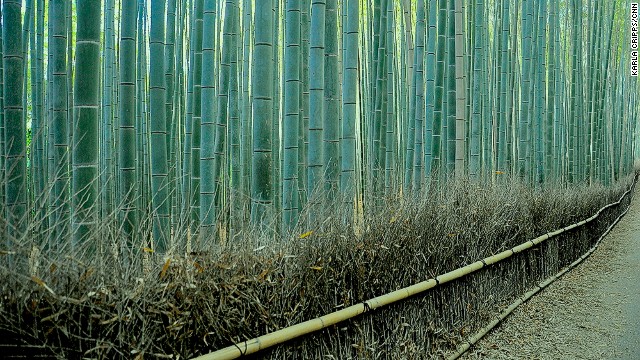The sun filters through the densely packed grove, projecting thin slashes of light onto the dozens of camera-clutching tourists shuffling down the wide trail that cuts through the middle of the forest as they awkwardly angle their shots, attempting to crop human forms out of their frames.Long gone are the days when you'd get this place to yourself.If you've ever clicked on a rundown of "places to see before you die" or a compilation of the most beautiful forests in the world, chances are you've seen a photo of Sagano.Located in the gorgeous Arashiyama district of western Kyoto, the Sagano Bamboo Forest's popularity has expanded in recent years, coinciding with the growing number of Buzzfeed-esque articles that include it on superlative-heavy travel lists.Though it's the beauty of the bamboo that brings in the masses, those distinct rustling sounds have become an attraction in their own right.A few years ago the Ministry of Environment included the Sagano Bamboo Forest on its list of "100 Soundscapes of Japan" -- a selection of everyday noises intended to encourage locals to stop and enjoy nature's music.For the best experience, it's best to head out early in the morning or late evening and avoid weekends completely, when Japanese day-trippers descend on the area -- especially in the fall and spring. (There's no admission fee and it's open 24/7.)A 'major' temple and a film star's former homeRight outside the Bamboo Forest entrance is the northern gate of Tenryu-ji Temple (open daily, 8:30 a.m.-5:30 p.m., admission 500 yen, about $5), a UNESCO World Heritage Site and one of the Kyoto-gozan -- five major temples of Kyoto.This is no coincidence.In Japan, Shinto shrines and Buddhist temples are often situated near bamboo groves, which are viewed as a clever means of warding off evil, while the bamboo is seen as a symbol of strength.Built in the 14th century by a shogun in honor of the passing of Japan's emperor, Tenryu-ji has one of the country's most incredible Zen gardens and is today the headquarters of the Rinzai School of Zen Buddhism.At the other end of the Bamboo Forest trail sits Okochi-Sanso Villa (open daily, 9 a.m.-4 p.m., admission 1,000 yen), the former home of late silent film star Denjiro Okochi.A massive complex of gardens with plants and trees that are famed for catering to all four seasons, there's also a temple, study, tea hut and museum highlighting the life of Denjiro.MORE: Japan's Toei Kyoto Studio Park: Samurai, ninjas and the original Power RangersExploring ArashiyamaThe bamboo forest and its bookend attractions of Tenryu-ji and Okochi-Sanso Villa may be the stars of the area for international tourism crowds, but the entire Arashiyama district is worth exploring.With its low-lying tree-covered mountains that tumble into the Hozu River, historic temples and charming streets, Arashiyama has been designated a National Historic Site and Place of Scenic Beauty by Japan.It's been attracting moneyed locals since the 8th century, when vacationing aristocratic families visited to check out the changing seasons' colors and go boating on the Hozu River.Today, one of the best ways to enjoy the natural beauty of the area is by hopping on the Sagano Scenic Railway -- also known as the Sagano Romantic Train.A retro-style steam train that runs seven kilometers along the Hozu River, it departs once every hour from the Sagano Torokko Station -- a short walk from the JR Arashiyama Sagano Station -- daily from 9 a.m. to 5 p.m., except Wednesdays. (The train shuts down from December 30-February 28.)The entire ride takes less than 30 minutes.Afterwards, many opt to hop on the bus that connects the train station to the river, where Hozu River Boat Rides depart for the two-hour, 16-kilometer trip from Kameoka back to Arashiyama.Boats run daily from 9 a.m. to 3:30 p.m., with reduced hours from December 1-March 1. Private charters are available.On land, bike rentals are among the best ways to explore Arashiyama's web of temples, shrines, restaurants and gift shops.The area's main icon, however, is the Togetsukyo Bridge (Moon Crossing Bridge), which flows over the Hozu River.Built during Japan's Heian Period (794-1185), when Kyoto was Japan's capital, it was reconstructed in the 1930s.Here, Japanese tourists can be seen posing for photos while dressed in colorful kimonos -- a nod to Kyoto's status as the cultural capital of Japan.After all that touring, a pit stop at one of the many soft-serve ice cream stands is a fine way to end the day -- the vanilla/green tea twists are particularly addictive.Arashiyama sidetracksThe Arashiyama crowds can get annoying, but the fantastic Otagi Nenbutsu-ji Temple is oddly overlooked by most tourists as it's a bit more remote than most of the district's attractions.About a 30-minute walk from the Sagano Bamboo Forest, it features over 1,000 little stone rakan (statues of enlightened ones) made from 1981 to 1991 during the reconstruction of the temple.Some laugh joyfully. Most pose serenely, covered in a green layer of moss.The odd one holds a tennis racket.On weekdays, the lovely uphill walk from the Sagano Bamboo Forest to Otagi Nenbutsu-ji is also surprisingly tourist-free yet full of unique gift shops -- including one owned by an artist who creates his works out of silk worm cocoons -- a massive traditional torii gate, tea rooms and private residences.If the kids are crying out for something a bit more lively, up on Mount Arashiyama sits the Iwatayama Monkey Park, home to some 100 Japanese macaques.What's cool about this place is that it's the humans who are in the cage, and the monkeys -- which you can feed -- on the outside.Getting in/where to stayFrom Kyoto Station, take Kyoto City Bus #28 or Kyoto Bus #71, #72, #73, or take the JR Sagano Line to Saga Arashiyama station.From downtown Kyoto, take City Bus #28 or #11. For trains, take the Keifuku Arashiyama Line to Arashiyama Station.For private tours of Arashiyama, Virtuoso-affiliated Windows to Japan offers an excellent western Kyoto itinerary that includes the highlights of the area.For those who want more than a day trip, the top hotel in Arashiyama is luxury ryokan Hoshinoya Kyoto, which can only be reached by ferry. Rates from 20,400 yen per person/night.(CNN)Bakudaily.Az
One of the most beautiful groves on Earth - PHOTO
World
21:00 | 12.08.2014

One of the most beautiful groves on Earth - PHOTO
In Japan's Sagano Bamboo Forest, on the outskirts of Kyoto, towering green stalks of the famously versatile plant sway in the wind, creaking eerily they collide and twist, leaves rustling.
Follow us !










